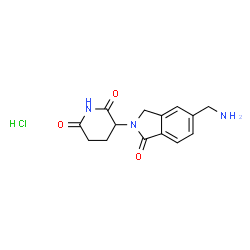3-(5-(aminomethyl)-1-oxoisoindolin-2-yl)piperidine-2,6-dione hydrochloride
Modify Date: 2025-08-25 18:10:04

3-(5-(aminomethyl)-1-oxoisoindolin-2-yl)piperidine-2,6-dione hydrochloride structure
|
Common Name | 3-(5-(aminomethyl)-1-oxoisoindolin-2-yl)piperidine-2,6-dione hydrochloride | ||
|---|---|---|---|---|
| CAS Number | 1158264-69-7 | Molecular Weight | 309.748 | |
| Density | N/A | Boiling Point | N/A | |
| Molecular Formula | C14H16ClN3O3 | Melting Point | N/A | |
| MSDS | N/A | Flash Point | N/A | |
Use of 3-(5-(aminomethyl)-1-oxoisoindolin-2-yl)piperidine-2,6-dione hydrochlorideLenalidomide-5-aminomethyl hydrochloride is the Lenalidomide-based cereblon (CRBN) ligand used in the recruitment of CRBN protein. Lenalidomide-5-aminomethyl hydrochloride can be connected to the ligand for protein by a linker to form PROTAC[1] |
| Name | 3-[5-(Aminomethyl)-1-oxo-1,3-dihydro-2H-isoindol-2-yl]-2,6-piperidinedione hydrochloride (1:1) |
|---|---|
| Synonym | More Synonyms |
| Description | Lenalidomide-5-aminomethyl hydrochloride is the Lenalidomide-based cereblon (CRBN) ligand used in the recruitment of CRBN protein. Lenalidomide-5-aminomethyl hydrochloride can be connected to the ligand for protein by a linker to form PROTAC[1] |
|---|---|
| Related Catalog | |
| Target |
Cereblon |
| In Vitro | PROTACs contain two different ligands connected by a linker; one is a ligand for an E3 ubiquitin ligase and the other is for the target protein. PROTACs exploit the intracellular ubiquitin-proteasome system to selectively degrade target proteins[2]. |
| References |
| Molecular Formula | C14H16ClN3O3 |
|---|---|
| Molecular Weight | 309.748 |
| Exact Mass | 309.088013 |
| InChIKey | XTILEMYXOZKSFJ-UHFFFAOYSA-N |
| SMILES | Cl.NCc1ccc2c(c1)CN(C1CCC(=O)NC1=O)C2=O |
| Hazard Codes | Xi |
|---|
| 2,6-Piperidinedione, 3-[5-(aminomethyl)-1,3-dihydro-1-oxo-2H-isoindol-2-yl]-, hydrochloride (1:1) |
| 3-[5-(Aminomethyl)-1-oxo-1,3-dihydro-2H-isoindol-2-yl]-2,6-piperidinedione hydrochloride (1:1) |
| MFCD31794744 |